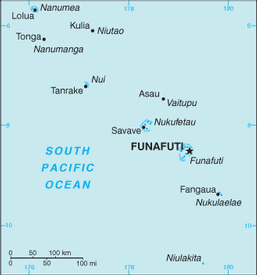Welcome to the Virtual Education Wiki ~ Open Education Wiki
Tuvalu: Difference between revisions
NikkiCortoos (talk | contribs) m (added template elements from the merged template) |
NikkiCortoos (talk | contribs) m (→Tuvalu in a nutshell: added map and changed population estimate) |
||
| Line 10: | Line 10: | ||
<!-- enter a few sentences - focus on name(s) of country, location, population, capital city --> | <!-- enter a few sentences - focus on name(s) of country, location, population, capital city --> | ||
<!-- (for almost all countries this has been done, but needs updating especially for population) --> | <!-- (for almost all countries this has been done, but needs updating especially for population) --> | ||
[[Image:Tuvalu map CIA-resource.gif|frame|right|Source: Original gif on: [https://www.cia.gov/library/publications/the-world-factbook/geos/tv.html the CIA's "The World Factbook" / Tuvalu]]] | |||
''Tuvalu'', formerly known as the '''Ellice Islands''', is a Polynesian island nation located in the Pacific Ocean midway between [[Hawaii]] and [[Australia]]. Its nearest neighbours are [[Kiribati]], [[Samoa]] and [[Fiji]]. | ''Tuvalu'', formerly known as the '''Ellice Islands''', is a Polynesian island nation located in the Pacific Ocean midway between [[Hawaii]] and [[Australia]]. Its nearest neighbours are [[Kiribati]], [[Samoa]] and [[Fiji]]. | ||
It comprises four reef islands and five true atolls with a gross land area of just 26 square kilometres (10 sq mi). In terms of physical land size, Tuvalu is the fourth smallest country in the world, larger only than the Vatican City—0.44 km²; Monaco—1.95 km² and Nauru—21 km². | It comprises four reef islands and five true atolls with a gross land area of just 26 square kilometres (10 sq mi). In terms of physical land size, Tuvalu is the fourth smallest country in the world, larger only than the Vatican City—0.44 km²; Monaco—1.95 km² and Nauru—21 km². | ||
Its population is around | Its population is around 10,544 (July 2011 est.). It is the third-least populated independent country in the world, with only Vatican City and Nauru having fewer inhabitants. | ||
It is also the second-smallest member by population of the [[United Nations]]. | It is also the second-smallest member by population of the [[United Nations]]. | ||
Revision as of 12:13, 22 June 2011
Experts situated in Tuvalu
None so far.
Tuvalu in a nutshell

Tuvalu, formerly known as the Ellice Islands, is a Polynesian island nation located in the Pacific Ocean midway between Hawaii and Australia. Its nearest neighbours are Kiribati, Samoa and Fiji.
It comprises four reef islands and five true atolls with a gross land area of just 26 square kilometres (10 sq mi). In terms of physical land size, Tuvalu is the fourth smallest country in the world, larger only than the Vatican City—0.44 km²; Monaco—1.95 km² and Nauru—21 km².
Its population is around 10,544 (July 2011 est.). It is the third-least populated independent country in the world, with only Vatican City and Nauru having fewer inhabitants.
It is also the second-smallest member by population of the United Nations.
The first inhabitants of Tuvalu were Polynesian people. The islands came under Britain's sphere of influence in the late 19th century. The Ellice Islands were administered by Britain as part of a protectorate from 1892 to 1916 and as part of the Gilbert and Ellice Islands Colony from 1916 to 1974. In 1974 the Ellice Islanders voted for separate British dependency status as Tuvalu, separating from the Gilbert Islands which became Kiribati upon independence. Tuvalu became fully independent within the Commonwealth of Nations in 1978.